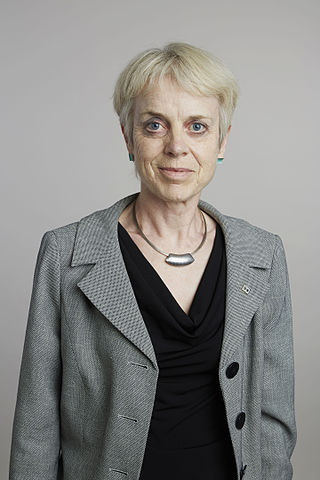
The GABA receptors are a class of receptors that respond to the neurotransmitter gamma-aminobutyric acid (GABA), the chief inhibitory compound in the mature vertebrate central nervous system. There are two classes of GABA receptors: GABAA and GABAB. GABAA receptors are ligand-gated ion channels ; whereas GABAB receptors are G protein-coupled receptors, also called metabotropic receptors.

Richard Henderson is a British molecular biologist and biophysicist and pioneer in the field of electron microscopy of biological molecules. Henderson shared the Nobel Prize in Chemistry in 2017 with Jacques Dubochet and Joachim Frank. "Thanks to his work, we can look at individual atoms of living nature, thanks to cryo-electron microscopes we can see details without destroying samples, and for this he won the Nobel Prize in Chemistry."
Dame Frances Mary Ashcroft is a British ion channel physiologist. She is Royal Society GlaxoSmithKline Research Professor at the University Laboratory of Physiology at the University of Oxford. She is a fellow of Trinity College, Oxford, and is a director of the Oxford Centre for Gene Function. Her research group has an international reputation for work on insulin secretion, type II diabetes and neonatal diabetes. Her work with Andrew Hattersley has helped enable children born with diabetes to switch from insulin injections to tablet therapy.

Gamma-aminobutyric acid B receptor, 1 (GABAB1), is a G-protein coupled receptor subunit encoded by the GABBR1 gene.
Gillian Patricia Bates FMedSci FRS is a British biologist. She is distinguished for her research into the molecular basis of Huntington's disease and in 1998 was awarded the GlaxoSmithKline Prize as a co-discoverer of the cause of this disease. As of 2016, she is Professor of Neurogenetics at UCL Institute of Neurology and the co-director of UCL Huntington's Disease Centre.
Charon Robin Ganellin FRS is a British medicinal chemist, and Emeritus Smith Kline and French Professor of Medicinal Chemistry, at University College London.

Stuart Graham Cull-Candy is a British neuroscientist. He holds the Gaddum Chair of Pharmacology and a personal Chair in Neuroscience at University College London. He is also a member of the Faculty of 1000 and held a Royal Society - Wolfson Research position.
Ann Jacqueline Hunter CBE FMedSci FBPharmacolS FRSB is a British scientist who is a board director of BenevolentAI. Hunter is also a visiting professor at St George's Hospital Medical School and Imperial College. She is Chair of the Trustees of the Sainsbury Laboratories at Norwich, chair of the board of the Stevenage Bioscience Catalyst and chair of the board of Brainomix. She was previously CEO of the Biotechnology and Biological Sciences Research Council.

Jane Clarke is an English biochemist and academic. Since October 2017, she has served as President of Wolfson College, Cambridge. She is also Professor of Molecular Biophysics, a Wellcome Trust Senior Research Fellow in the Department of Chemistry at the University of Cambridge. She was previously a Fellow of Trinity Hall, Cambridge. In 2023, she was elected to the National Academy of Sciences.

Annette Catherine Dolphin is a Professor of Pharmacology in the Department of Neuroscience, Physiology and Pharmacology at University College London (UCL).

Benjamin Guy Davis is Professor of Chemical biology in the Department of Pharmacology and a member of the Faculty in the Department of Chemistry at the University of Oxford and a Fellow of Pembroke College, Oxford. He holds the role of Science Director for Next Generation Chemistry (2019-2024) and Deputy Director (2020-) at the Rosalind Franklin Institute.

Antony Giuseppe Galione is a British pharmacologist. He is a professor and Wellcome Trust senior investigator in the Department of Pharmacology at the University of Oxford.

David Lodge is a research fellow in the Department of Physiology and Pharmacology at the University of Bristol.
Professor Norman Bowery, was a British pharmacologist and former Head of Division of Neuroscience and Chair of Pharmacology at the University of Birmingham from 1995 to 2004. He was president of the British Pharmacological Society from 1995 to 1997 and from 1999 to 2000.
Professor Patrick Humphrey OBE DSc PhD HonFBPhS is a South African-born British pharmacologist. He was instrumental in the discovery of the triptans, a group of 5-HT1B and 5-HT1D agonists used to stop single instances of cluster headache or migraine.
Julia Clare Buckingham is a British pharmacologist, academic and academic administrator. She is the former Vice Chancellor of Brunel University London, UK.
Sir Colin Terence Dollery was a clinical pharmacologist who spent much of his life working for SmithKline Beecham and its successor, Glaxo Smith Kline. He was knighted in the Queen's 1987 birthday honours. He was an honorary fellow of the British Pharmacological Society and a fellow of the Academy of Medical Sciences.

3-Aminopropylphosphinic acid, also known in the literature as 3-APPA or CGP 27492, is a compound used in scientific research which acts as an agonist at the GABAB receptor. It is part of a class of phosphinic acid GABAB agonists, which also includes SKF-97,541. It has a binding affinity (pKi) to the GABAB receptor of 8.30.
Clare Bryant FLSW is a British veterinary scientist and clinical pharmacologist who is a professor at the University of Cambridge. She specialises in innate immunity. Bryant is a Fellow of Queens' College, Cambridge and of the British Pharmacological Society.
Arthur Henry Weston is emeritus professor at the University of Manchester, where he was previously Leech Professor of Pharmacology from 1989-2011.










